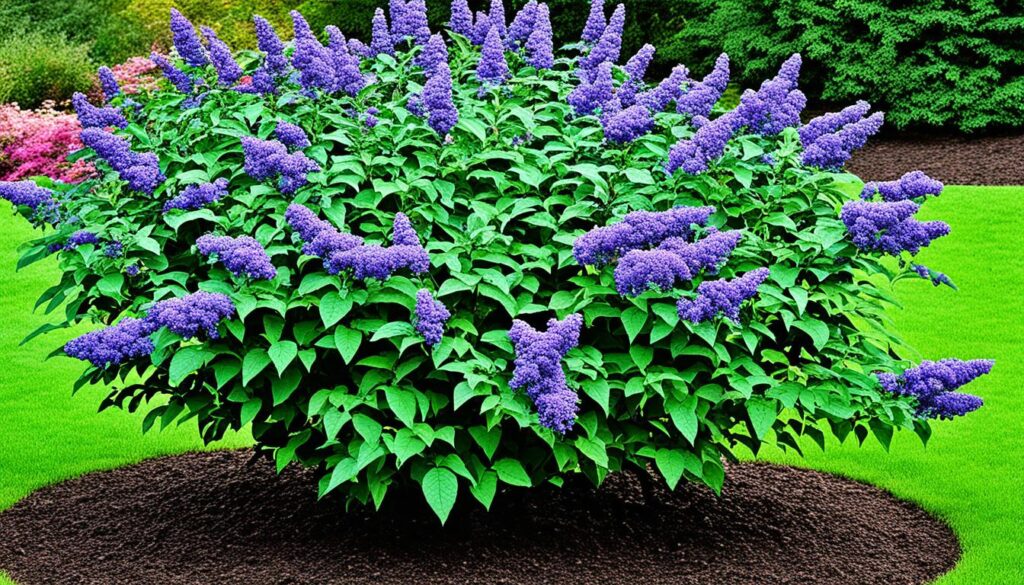Welcome to your guide on Callicarpa americana, also known as American beautyberry. This shrub is great for your garden. It’s loved for its purple berries and helps attract wildlife. It grows well in USDA hardiness zones 6 to 10, reaching 3 to 6 feet tall.
This plant does best in rich soil and lots of sunlight. It adds beauty to your garden in fall and keeps insects away. Let’s learn how to grow a healthy Callicarpa americana. This will make your garden beautiful and help local wildlife.
Introduction to Callicarpa Americana
Callicarpa americana, also known as American beautyberry, is a beloved native shrub. It is known for its beautiful looks and its important role in nature. In spring and early summer, it blooms with delicate flowers. These flowers turn into bright purple berries that attract many animals.
This plant is great for any garden, adding beauty as a backdrop or as a main feature. To make sure it grows well, know where it naturally grows. Planting it right makes your garden look better and helps the environment.
Following good care tips will make your garden beautiful. Callicarpa americana adds beauty and helps nature with its presence. It’s perfect for gardeners wanting more life in their gardens.
Sun Exposure and Ideal Growing Conditions

Callicarpa americana, also known as American beautyberry, is very flexible with sunlight and soil. Knowing these things is key for its health and growth.
Full Sun vs. Partial Shade
American beautyberry does well in both full sun and partial shade. With lots of sunlight, it makes more berries. It likes at least two hours of direct sun each day.
In hot places, partial shade helps protect it from the strong afternoon sun. This makes it perfect for gardens near woods.
Soil Preferences for Optimal Growth
Callicarpa americana needs well-drained, loamy soil with lots of organic stuff. The best soil pH is between slightly acidic to neutral (5.0-7.0).
It can handle clay soils but doesn’t like poor drainage, which can cause root rot. Adding compost in spring helps the soil and makes the plant grow better.
For more tips on gardening, check out this comprehensive guide to planting in January.
Watering Needs for Callicarpa Americana

It’s key to know how much water callicarpa americana needs to grow well. These shrubs like moist soil but can handle drought once they’re set. Finding the right balance in watering keeps your beautyberry healthy and stops problems from overwatering.
Moisture Requirements
Callicarpa americana needs about 1 inch of water each week for best growth. If it’s hot or dry for a long time, you might need to water more often. Check the soil moisture and adjust watering based on it. Beautyberry plants can get by with less water if they’re well-rooted.
Watering Techniques and Frequency
How you water callicarpa americana is important for its health. Water at the base to help roots grow deep. Using a soaker hose or drip irrigation waters efficiently without making the soil too wet. Water when the top inch of soil feels dry.
Don’t water too much too often, as it can make roots weak. A steady 1 inch of water a week is best for your beautyberry. Here’s a simple table to guide you on watering:
| Watering Method | Recommended Frequency | Benefits |
|---|---|---|
| Soaker Hose | Once per week | Delivers water directly to roots |
| Drip Irrigation | As needed | Efficient moisture retention |
| Hand Watering | As checks indicate | Allows for personal monitoring |
Soil and Fertilization Guidelines
When you think about planting callicarpa americana, picking the right soil is key. This shrub grows well in many types of soil. It’s great for different gardens. The right soil makes this beautyberry thrive.
Types of Soil for Planting
Callicarpa americana likes soil that drains well and is rich in organic matter. Here are some good soil types to use:
- Sandy Soil – Good drainage and air circulation.
- Clay Soil – Keeps moisture in but needs better drainage.
- Loamy Soil – A mix of sand, silt, and clay for nutrients and drainage.
Adding compost to your soil helps with nutrients. This is good if your soil seems poor. Healthy soil means your callicarpa americana grows better, giving you pretty purple berries.
Fertilizing Techniques and Practices
Callicarpa americana is easy to care for, but it has fertilization tips. You usually don’t need much fertilization unless your soil lacks nutrients. Here’s what to do:
- Check your soil’s nutrient levels before planting.
- Give a balanced fertilizer in early spring if needed.
- Don’t overdo it with fertilizers, as too much can hurt berry production.
These easy techniques keep your beautyberry healthy and full of berries. Your shrub will do well all season.
| Soil Type | Characteristics | Usage Tips |
|---|---|---|
| Sandy Soil | Good drainage, dry quickly | Mix with organic matter to retain moisture |
| Clay Soil | Holds moisture; compact | Amend with sand or compost to improve drainage |
| Loamy Soil | Ideal nutrient retention and drainage | No amendments needed, it’s perfect as is |
Pruning and Maintenance Tips for American Beautyberry

Keeping your callicarpa americana in shape is key for lots of berries and a healthy shrub. Using the right pruning helps your beautyberry look great and stay healthy.
When and How to Prune
Prune your callicarpa americana in late winter or early spring, right before new growth starts. This helps the plant recover well. Remove dead or weak branches during pruning.
This makes sure air can move freely, which stops diseases. For big shrubs, cut them back to about 1 foot from the ground each year. This is especially good for areas with harsh winters.
Maintaining Shrub Shape and Health
Regular care keeps your beautyberry shrub looking good and helping with berry production. Watch for diseases or pests, even though these plants are strong against them. Proper pruning boosts air flow, lowers disease risk, and makes the shrub fuller.
Using maintenance tips for other plants can also help your garden do well.
Attracting Wildlife with Your Callicarpa Americana
Adding Callicarpa americana, or American Beautyberry, to your garden is great for nature. This plant looks beautiful with its purple berries from August to October. It also helps local wildlife by being a food source and a home.
By using American Beautyberry in your garden, you help many birds and animals. This makes your garden a better place for nature.
Birds and Other Wildlife Benefits
The berries of Callicarpa americana are a key food for birds in the cold months. Birds like robins and bluebirds visit gardens with these berries. The plant’s leaves also give shelter to small animals.
This makes your garden a place where many animals can live and thrive. Adding native plants helps birds and pollinators. This is good for your garden’s health.
Creating a Wildlife-Friendly Garden
To make a wildlife-friendly garden, plant different native plants with Callicarpa americana. Use plants that bloom and fruit at various times. This makes your garden more interesting for animals.
Try adding Bee Balm for hummingbirds and butterflies, and Black-eyed Susans for bees. A garden full of native plants is great for watching wildlife. For more tips on plants, see this guide.
Common Challenges and Solutions in Growing Callicarpa Americana
Growing Callicarpa americana is usually easy. But, you might face a few common issues. One big problem is not enough sunlight, which can stop your beautyberry shrubs from blooming. Make sure your plants get lots of sunlight, ideally full sun to some shade. Checking how much light they get helps you fix this problem.
Another issue is pests. Beautyberry shrubs are tough and don’t often get sick. But, watch out for pests. Use pest management methods that don’t harm good insects and animals. Check your plants often for any signs of pests, like weird colors or growth.
For more tips on growing this lovely shrub, check out this useful guide. Talk to local gardening groups or experts for more advice. By knowing these common problems and how to fix them, you can make sure your Callicarpa americana grows well.



